BY 124- Gibbons Ch 30- Plant Diversity II
1/61
There's no tags or description
Looks like no tags are added yet.
Name | Mastery | Learn | Test | Matching | Spaced |
|---|
No study sessions yet.
62 Terms
When you see a fern frond in the forest, you are looking at:
A. A Sporophyte
B. A Gametophyte
C. Both Sporophyte and Gametophyte
D. A non-vascular plant
A. A Sporophyte
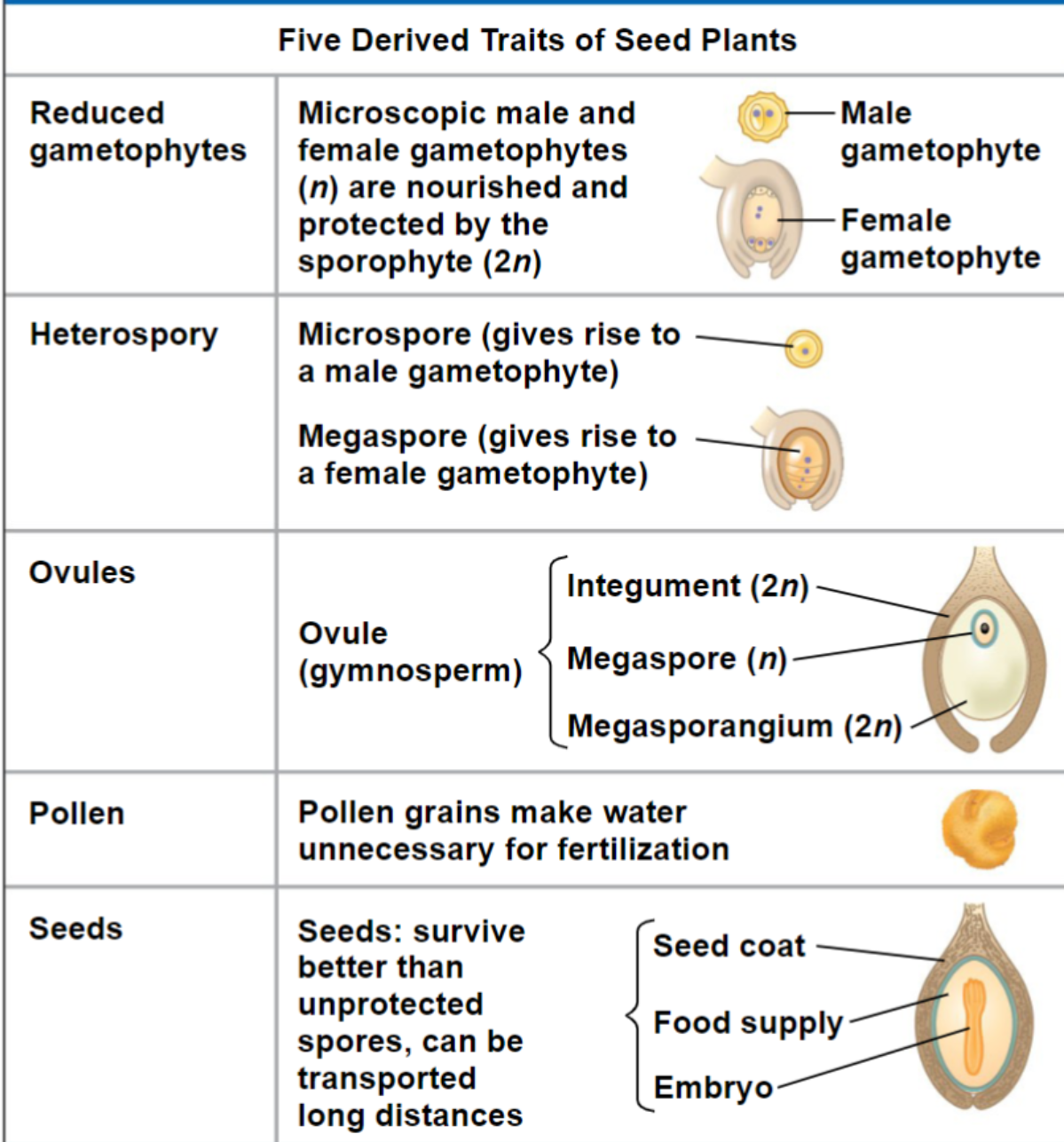
What are the 5 derived characteristics of vascular, seed-bearing plants?
Reduced gametophytes
Heterospory
Ovules
Pollen
Seeds
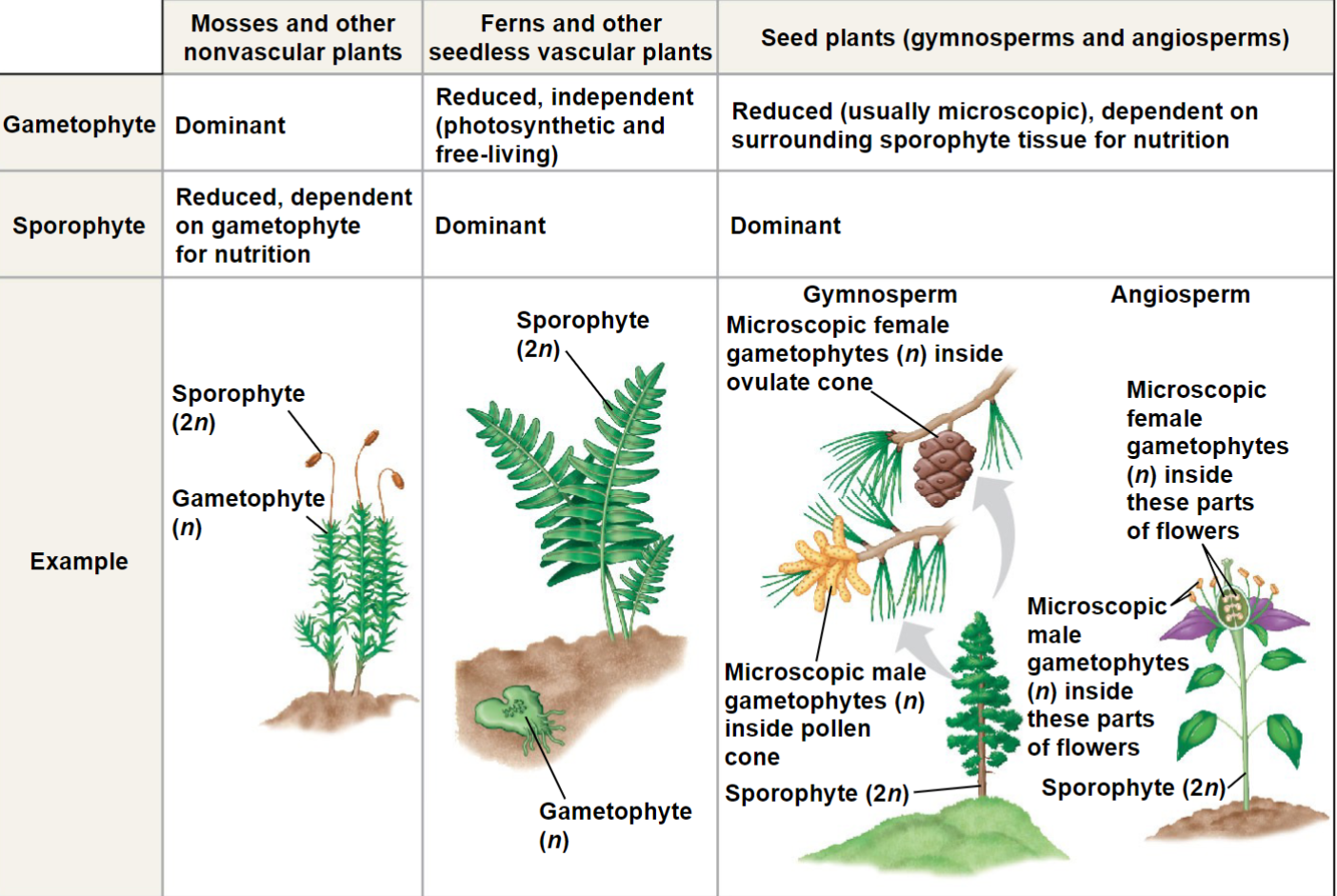
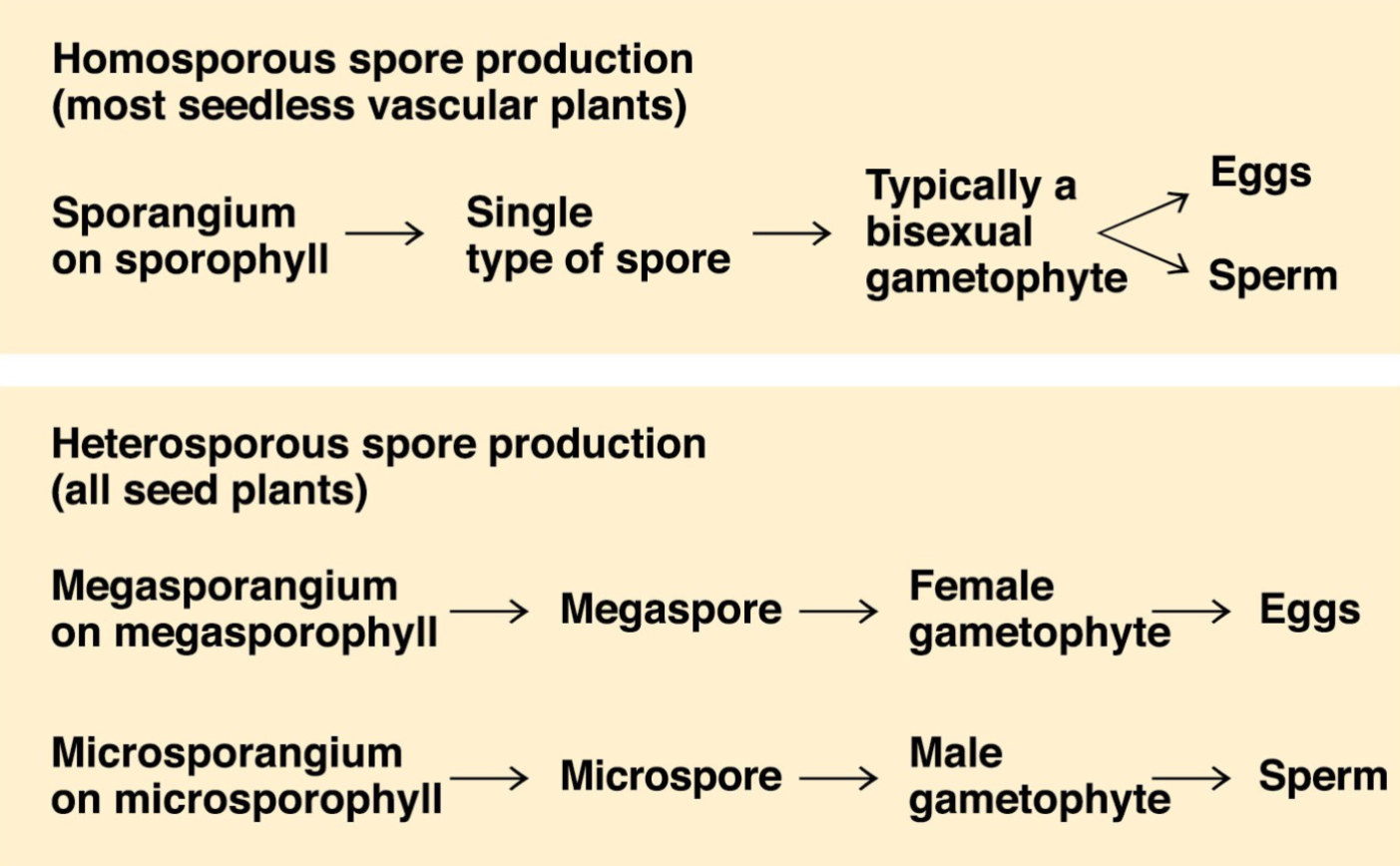
Homosporous spore production- single type of spore
Heterosporous
Homosporous and Heterosporous spore production
The megaspore turns into the:
A. Pollen
B. Male gametophyte
C. Female gametophyte
D. Egg
D. Egg
__________ megasporangia have _____ integument, while ___________ megasporangia usually have ____ integuments
Gymnosperm ; 1 :: angiosperm ; 2
An _____ consists of a megasporangium, megaspore, and one or more protective integuments
ovule
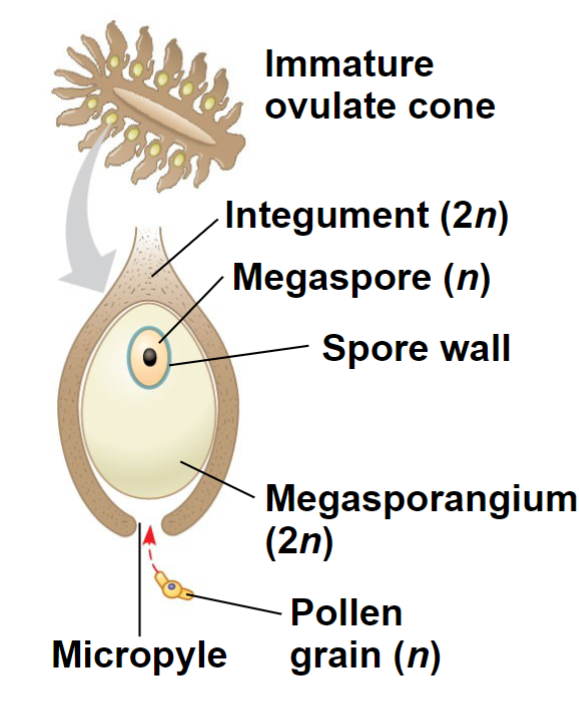
This image depicts an _________ ___________.
Unfertilized ovule
A microspore develops into a ______ _____ that consists of a male gametophyte enclosed within the pollen wall
pollen grain
________ is the transfer of pollen to the part of a seed plant containing the ovules.
Pollination
A germinated pollen grain produces a pollen tube that discharges sperm into the female _____________ within the ________
gametophyte ; ovule

This image depicts a __________ _______.
Fertilized ovule
The Evolutionary Advantage of Seeds
If a sperm fertilizes the egg of a seed plant, the ovule will develop into a seed
A seed is a sporophyte embryo, along with its food supply, packaged in a protective coat
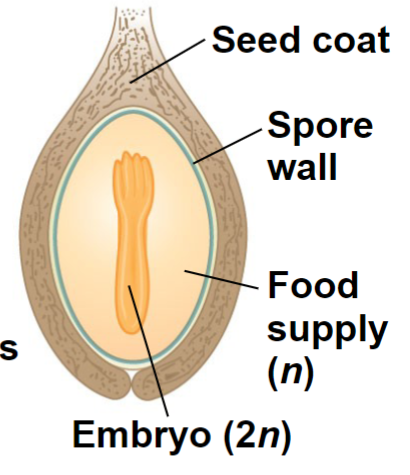
This image depicts a _____________ _______.
gymnosperm seed
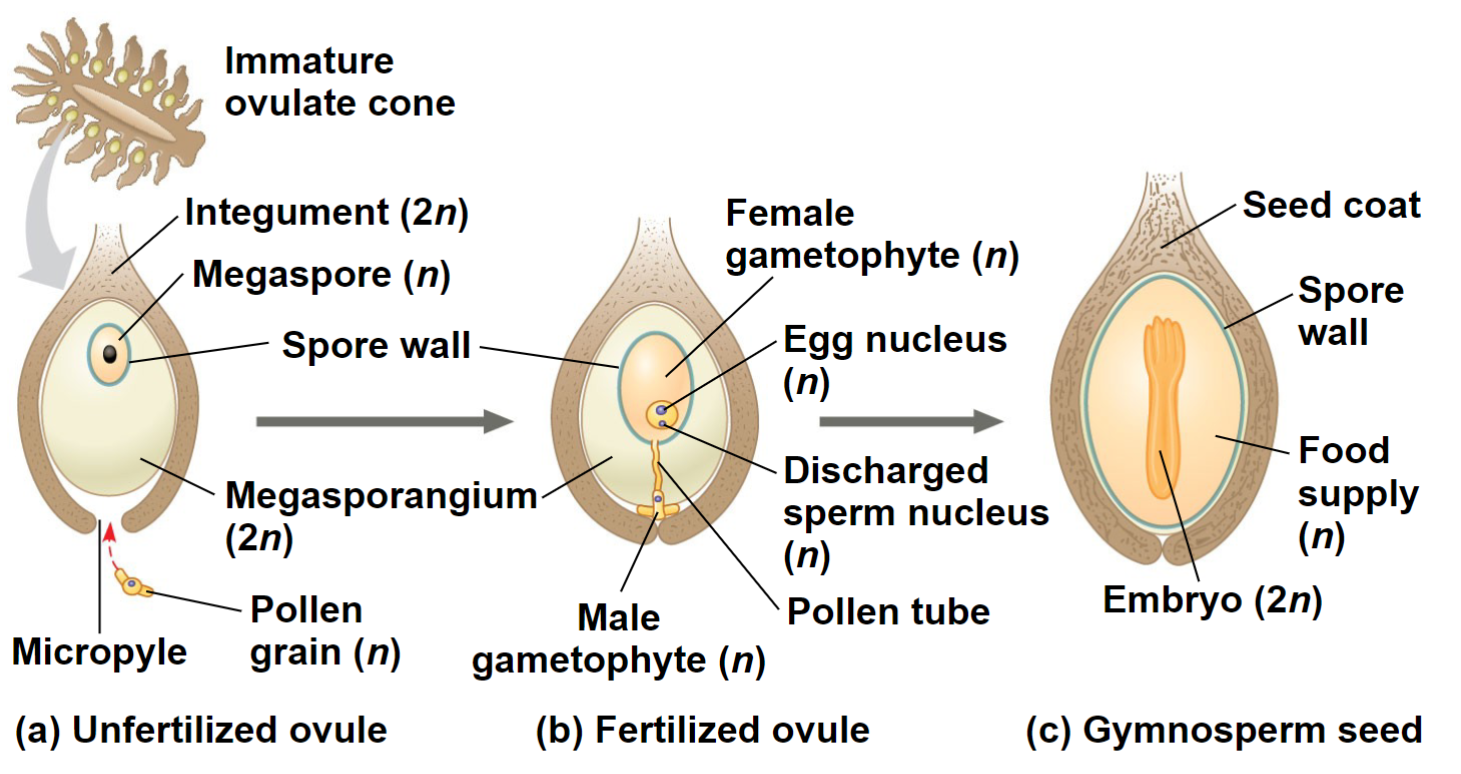
This diagram represents ________.
fertilization
What evolutionary advantages do seeds provide?
They may remain dormant for days to years, until conditions are favorable for germination
They have a supply of stored food
They may be transported long distances by wind or animals
Protection

True or False: Seed-producing plants (Angiosperms and Gymnosperms) make up a clade.
True
The gymnosperms consist of 4 phyla. Name them.
Cycadophyta (cycads)
Ginkgophyta (one living species: Ginkgo biloba)
Gnetophyta (three genera: Gnetum, Ephedra,
Welwitschia)
Coniferophyta (conifers, such as pine, fir, and
redwood)
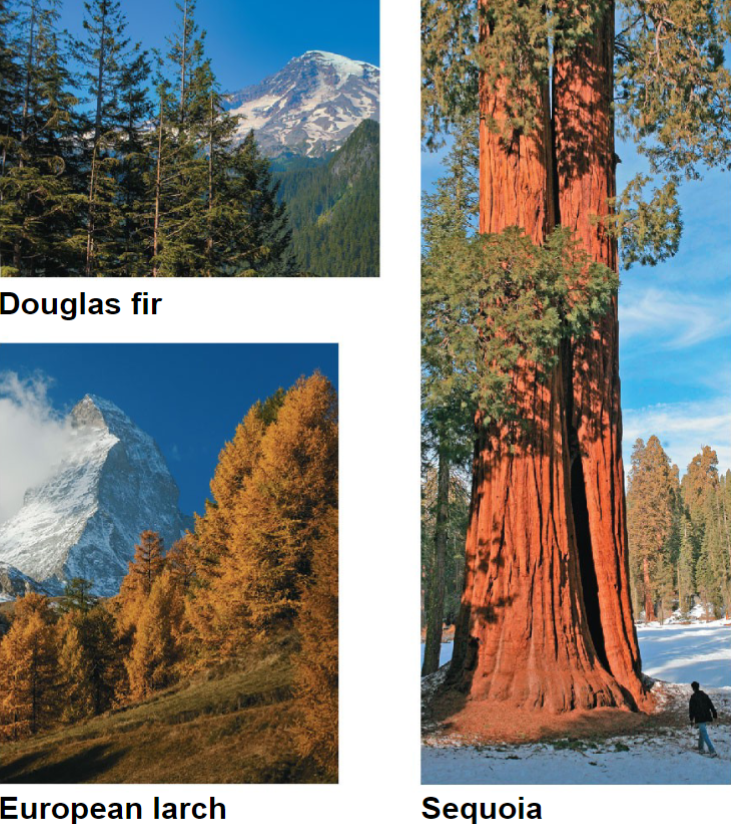
Phylum Coniferophyta
Largest of the gymnosperm phyla
Most have woody cones, but a few have fleshy cones
Most are evergreens and can carry out photosynthesis all year round
Life Cycle of Phylum Coniferophyta
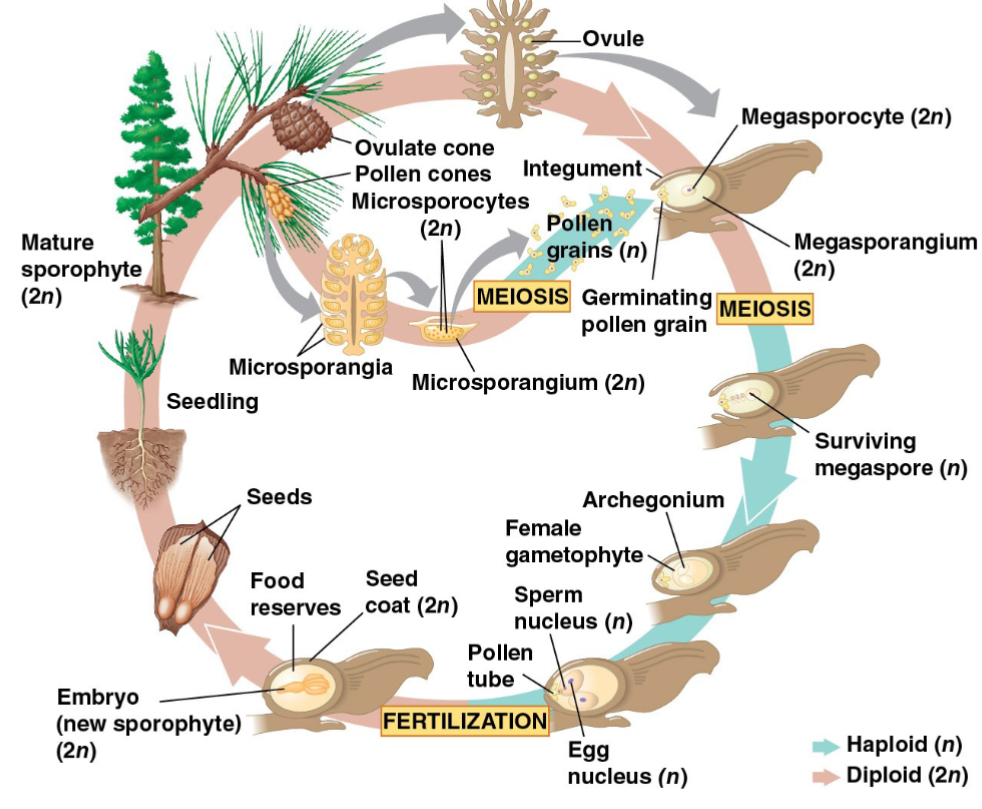
Characteristics of Angiosperms
All angiosperms are classified in a single phylum, Anthophyta
Angiosperms have two key adaptations
Flowers
Fruits
Angiosperm structure specialized for sexual reproduction
Flower
The act of moving pollen from male structures of structures to female structures of flowers
Pollination
The act of moving pollen from male structures of structures to female structures of flowers on the same plant
Self-pollination
The act of moving pollen from male structures of structures to female structures of flowers on a different plant, but of the same species
Cross-pollination
Pollination can occur through many means, including _____ _____ and ________
animal transport ; wind
Diagram of a flower
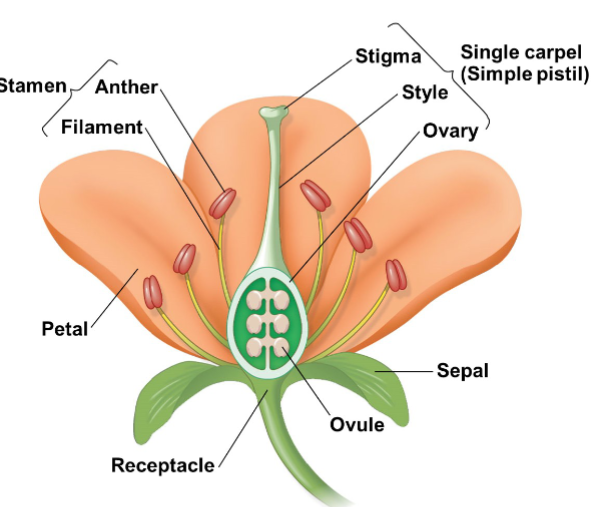
Which of the following terms is associated with a MALE flower structure?
A. sepal
B. stigma
C. pistil
D. stamen
D. Stamen
Characteristics of fruits
A fruit is formed when the ovary wall thickens and matures
Fruits protect seeds and aid in their dispersal
Mature fruits can be either fleshy or dry
Angiosperm phylogeny
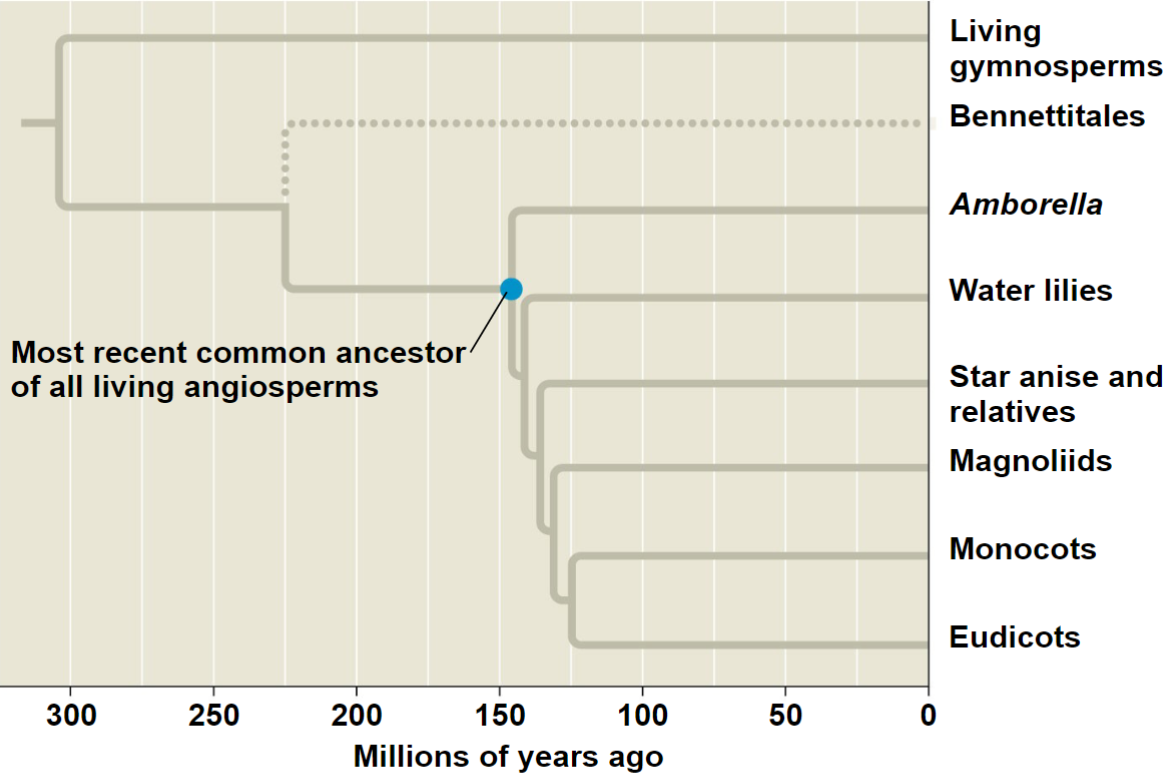
Monocot vs Eudicot characteristics

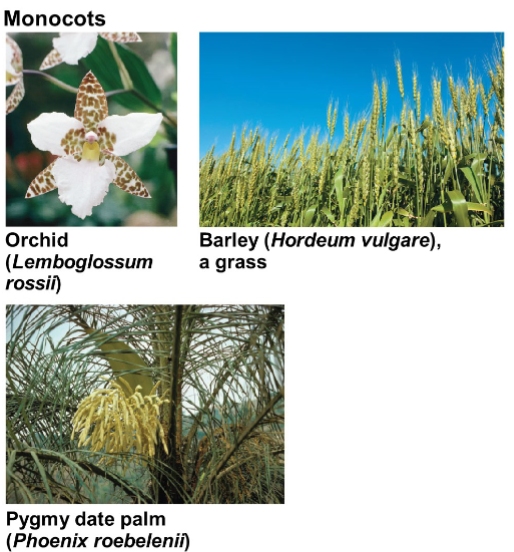
Characteristics of Monocots
About one-quarter of angiosperms, about 70,000 species, are monocots
The largest groups are the orchids, grasses, and palms
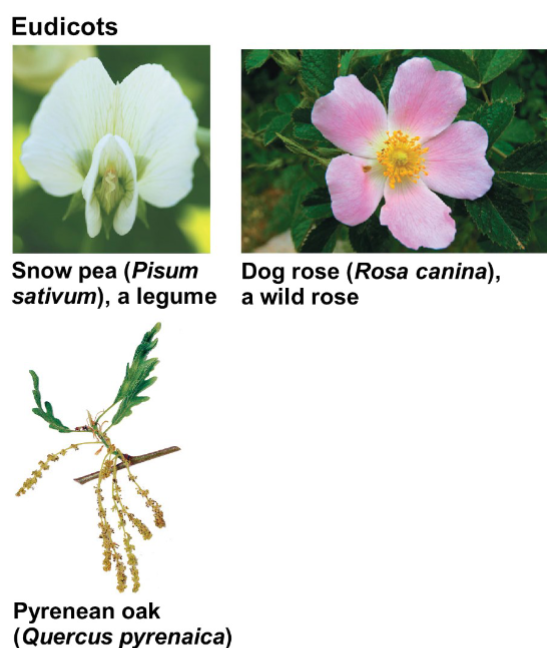
Characteristics of Eudicots
More than two-thirds of angiosperms, about 170,000 species, are eudicots
Eudicots include the large legume family and the economically important rose family
Seed plant importance to humans
Food: most of our food comes from angiosperms
Six crops (corn, rice, wheat, potatoes, sweet potatoes, cassava) make up 80% of human-consumed calories
Wood: all comes from seed-bearing plants
Fuel, paper, construction
Medicines: many plants have useful medicinal compounds
25% of current pharmaceuticals use plant compounds (to treat pain, eye dilation, cancer, heart medication, etc)
The seed coat’s most important function is to provide protection for the __________.
megasporangium
male gametophyte
megaspore
female gametophyte
sporophyte embryo
sporophyte embryo
Besides the plant tissue that humans ingest, which angiosperm tissue is most directly important for human survival?
Sepals
Xylem
Cones
Phloem
Bark
Xylem
The dicots are now thought to be in the paraphyletic group, and the majority of dicot species are now placed in the eudicots. Which of the following is a member of a group that was included in the dicots but is now included in the eudicots?
Orchid
Barley
Black walnut
Date palm
Southern magnolia
Southern magnolia
Dietary supplements and decongestants containing ephedrine have recently become more strongly regulated in the United States. Ephedrine is an extract of a plant belonging to which phylum?
Phylum Cycadophyta
Phylum Coniferophyta
Phylum Gnetophyta
Phylum Ginkgophyta
Phylum Anthopyta
Phylum Gnetophyta
Which of the following is not an advantage seeds provide over spores?
Asexual reproduction
Protective integument
Stored food supply
Long period of dormancy
Multicellularity
Asexual reproduction
Which of the following is a trait possessed by all angiosperms?
Seeds produced in ovulate cones
Seeds dispersed by animals
Pollination by animals
Free-living gametophyte
Double fertilization
Double fertilization
A plant is said to be cross-pollinated if __________.
its source of pollen is a different species of plant
it is pollinated by wind
pollen grains are transferred from a different flower on the same plant
it is pollinated by insects
pollen grains are transferred to a flower on a different plant
pollen grains are transferred to a flower on a different plant
Of the following, which is a difference in how reproduction occurs in gymnosperms compared to angiosperms?
Only angiosperm pollen grains form pollen tubes.
Only gymnosperms can contain male and female sporangia on the same plant.
Double fertilization only occurs in gymnosperms.
Only angiosperms have reduced gametophytes.
Only the sperm of angiosperms combine with two central cell nuclei to form triploid endosperm.
Only the sperm of angiosperms combine with two central cell nuclei to form triploid endosperm.
In which phylum is the organism thought to be the world’s oldest living tree?
Ginkgophyta
Coniferophyta
Cycadophyta
Gnetophyta
The world’s oldest living tree is not in any of the listed phyla.
Coniferophyta
Which example below is evidence provided by living gymnosperms of an evolutionary transition between seedless and seed plants?
The sperm of gymnosperms do not require water or mobility for fertilization.
The sperm of some gymnosperms have flagella.
Gymnosperms only have one integument.
In gymnosperms, two sperms are discharged into the pollen tube.
Some gymnosperms do not have reduced gametophytes.
The sperm of some gymnosperms have flagella.
Six major crops—wheat, rice, maize, potatoes, cassava, and sweet potatoes—constitute what percentage of all the calories consumed by humans?
30%
90%
80%
65%
50%
80%
A pea pod is formed from __________. A pea inside the pod is formed from __________.
an ovary; a pollen grain
an anther; an ovule
endosperm; an ovary
an ovary; an ovule
an ovule; a carpel
an ovary; an ovule
In addition to seeds, what is a trait unique to seed plants?
Heterospory
Use of wind as a means of dispersal
Pollen
Phloem
Sporangia
Pollen
Which of the following best describes the function of fruits?
Protection and dispersal of seeds
Reward for pollinators
Depending on the plant species, any of the listed responses are possible
To distract herbivores from eating the leaves
Food storage for the plant to use over the winter
Protection and dispersal of seeds
In flowers, pollen is produced in the __________.
stigma
anther
sepal
style
petal
Anther
The closest seedless relatives of seed plants produce one kind of spore that gives rise to a bisexual gametophyte. What does this suggest about the ancestors of seed plants?
They produced separate male and female gametophytes.
They were bryophytes.
They were homosporous.
They were heterosporous.
They were gymnosperms.
They were homosporous
In which group is the sporophyte stage dominant in the alternation of generations?
Only the ferns
Only seed plants
All land plants
Only nonvascular plants
All vascular plants
All vascular plants
Which of the following is not a trait characteristic of monocots?
Parallel leaf venation
Pollen grain with one opening
Floral organs in multiples of three
One cotyledon
Taproot
Taproot
The pore in the integuments of an angiosperm ovule through which sperm is delivered is the __________.
embryo sac
micropyle
pollen tube
stigma
sepal
micropyle
In gymnosperms, the seed coat develops from the integument. In angiosperms, the seed coat develops from the __________.
ovary wall
receptacle
female gametophyte
integuments
endosperm
integuments
The diploid generation of the plant life cycle always __________.
is called the gametophyte
is larger and more conspicuous than the haploid stage
produces spores
develops from a spore
produces eggs and sperm
produces spores
A bright pink flower with deep floral tubes will most likely be pollinated by which mechanism?
Wind
Self-pollination
Honeybees
Birds with long beaks
Bats
Birds with long beaks
Which of the following is not a gymnosperm?
Ginkgo
Sequoia
Douglas fir
Ephedra
Coconut palm
Coconut palm
Angiosperms are thought to have originated in which period?
Triassic
Silurian
Cretaceous
Ordovician
Paleogene
Cretaceous
At current rates of deforestation, tropical rain forests will be eliminated in __________ years.
250
1,000
200
50
10
200
Which gymnosperm phylum below is characterized by large cones and fern-like leaves and thrived during the Mesozoic?
Ginkgophyta
Gnetophyta
Coniferophyta
Cycadophyta
Anthopyta
Cycadophyta
Which of the following is a conifer?
Longleaf pine
European larch
Sequoia
All of the listed responses are conifers.
Common juniper
All of the listed responses are conifers.
What significant change occurred on Earth between the Carboniferous period and the Permian period that most likely contributed to the success of the gymnosperms?
An asteroid hit Earth, leading to mass extinctions that made way for gymnosperms to take over lands where other plants had perished.
Reptiles decreased in diversity and were replaced with amphibians better adapted for seed dispersal.
The breakup of Pangaea changed the flora and fauna of Earth dramatically.
The climate became drier and warmer.
Insects developed flight.
The climate became drier and warmer.
Which of the following is enclosed within the pollen wall of a pollen grain?
Megasporangium
Microsporangium
Embryo
Female gametophyte
Male gametophyte
Male gametophyte